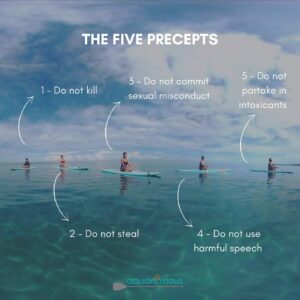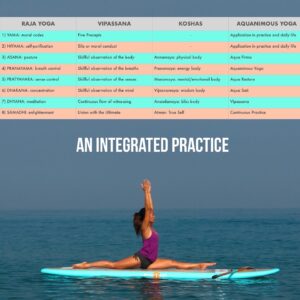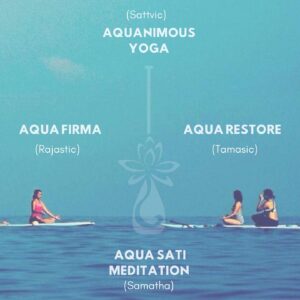
15 Aug An Integrated Yoga and Vipassana Practice
The goal of yoga is yoga itself. Union itself of the little self and the Real Self. A process of awakening to the pre-existing union that is called Yoga. It has to do with the realization, through direct experience, of the center of consciousness or Real Self.
Yoga views the human being as manifesting outward step by step (from the subtle body/Real Self to the gross body/outer world) where the subtler consciousness projects evermore outward and then gradually forgets those subtler levels.
In Aquanimous Yoga, we will move inward from the gross body to the subtle body wherein each aspect of the self is trained independently while also being trained to flow together. Our systematic process deal one by one with our actions in the world, senses, body, breath and both the conscious and unconscious aspects of mind towards union or realization.
Integrating all of this with the systems and philosophy of Ashtanga Yoga and Vipassana Meditation, our classes are designed to help you systematically investigate each aspect with some depth so it has a chance to take root in your body and nervous system thus becoming an integrated part of who you are.
Over the course of our program, you will also build an embodied understanding of awareness and equanimity (both external and internal), as well as loving kindness and compassion so you may engender an enduring state of equipoise in all levels of your being.
OUR ROOTS

From Asana to Samadhi: Yoga asanas prepare the mind and body for meditation. In the same way, we will find, that as we improve in our meditation practice our asana practice deepens as well because our concentration becomes sharper; we begin to discover the inner dimensions of our life. This self-discovery, practiced with self-acceptance, compassion and equanimity, allows us to change destructive habit patterns and therefore our life and relationships. This is the essence of spiritual practice.
Ashtanga Yoga and Vipassana Meditation are the pillars of Aquanimous Yoga. They are the two most time-tested ancient techniques for keeping the body, mind and spirit in harmony and in sync. There is no contradiction between the two. They are complementary to each other. Yoga asanas were developed for preparing the body and mind for the purpose of sitting in long meditation and as a preparation for receiving higher wisdom.
The sequence of Ashtanga Yoga and its techniques like ujjayi breathing, bandha, dristi and subtle body awareness are necessary to purify the body and the nervous system. Its whole process was designed to eliminate the pervasive impurities in body and mind.
Vipassana Meditation technique is a tool for mental purification. It is done through experiential and non-judgmental self-observation. Through experiential understanding of the impermanence, non-self and dissatisfaction in all phenomena, deeper insights and wisdom develops leading to eradication of the seeds of suffering. Observation of the moment-to-moment experience cleanses the mental layers, one after another and gradually, higher wisdom appears.
In our modern times, I have found that most yoga practitioners get trapped in the superficial, external objects such as achieving the “perfect pose” rather than moving deeper into meditation. Even the techniques of concentration practices do not lead to complete mental purification and the practice often do not succeed in the development of deeper wisdom and insight about reality, which is necessary for permanent happiness. This is where Vipassana Meditation helps.
On the other hand, due to its defect in implementation, many Vipassana practitioners suffer from a variety of mental and physical problems. Particularly, these type of problems arise in long Vipassana meditation courses. Deep seated fears, anxiety, anger and other emotions come to the surface of the mind and the practitioner is unable to maintain equanimity when such patterns of thought or mental visions come up. However, just by practicing a few energy balancing and dynamic yoga asanas, these imbalances are often cured and people return to their normal healthy life.
Only when our body and mind are prepared, we can derive the benefits of Vipassana. Yoga prepares the body and mind for receiving the higher wisdom and understanding that Vipassana Meditation brings up. When we practice them together, we get the maximum benefit from both.

AY is a comprehensive, holistic approach to health, happiness, and wellbeing. Rather than just addressing the physical body, we ascertain that all the five layers (or koshas) of the human body—physical, energetic, emotional-mental, wisdom and bliss body—are addressed for overall balance and harmony to take place.
Eastern Philosophy suggests that the human body is composed of five (5) Koshas or energetic layers. These are layers of manifest and unmanifested energy that surround our true self, or the Atman.
The Atman, buried deep within the Koshas, is our true self which remains unaffected by pleasure or pain. The concept of Atman is defined by Samkhya as the Self, or the soul which unlike other schools’ states that each Atman is unique.
The five Koshas are key to enhancing awareness of our inner world and developing a connection among our mind, body, and spirit. Attention to our koshas may awaken deeper states of awareness on our path to self-realization. Self-knowledge is the key to realising the truth.
Starting from the outside in the layers are:
1 – Annamaya Kosha: the physical body
2 – Pranamaya Kosha: the energetic body
3 – Manomaya Kosha: the mental and emotional body
4 – Vijnanamaya Kosha: the wisdom body
5 – Anandamaya Kosha: the bliss body; consciousness; seat of
awareness

THE WHEEL OF CLARITY. Clarity stops the cycle of samsara. The spokes on the wheel of clarity are the 8 steps of the Buddha’s path. Its hub is the combination of compassion and wisdom. This wheel is in motion because spiritual practice is dynamic, always active and moving. We should put into practice every aspect of the wheel of clarity to liberate ourselves from suffering.
In Buddhism, the Three Marks of Existence are three characteristics of all existence and beings, namely impermanence (anicca), non-self (anatta) and dissatisfaction or suffering (dukkha). It says that the cause of our suffering is ignorance (avidya), which is our delusion about these three marks, and that the removal of this delusion results in the end of suffering. This is the central theme in the Buddhist Four Noble Truths and the Noble Eightfold Path.
The practice is about liberating the mind. To accomplish this, the Buddha taught his path of morality (sīla), concentration (samādhi), and wisdom (pañña). These are the three divisions of the Noble Eightfold Path (also called the Middle Way or the Threefold Way), which is the fourth part of the Four Noble Truths. It gives us a path we can follow to end dukkha and ultimately achieve enlightenment.
FOUR NOBLE TRUTHS:
1 – Suffering: refers to the unhappiness we feel in our lives (samsara)
2 – Cause: our undisciplined, grasping mind (avidya)
3 – End: we can end suffering by eradicating our craving
4 – Path: the 8 steps we must take to end suffering
NOBLE EIGHTFOLD PATH
The 4th Noble Truth is the path that leads to the end of dissatisfaction. Its eight steps bring peace and happiness to those who follow them:
• Step one: Skillful Understanding of the Buddha’s message requires that we understand skillful behavior in terms of cause and effect and the Four Noble Truths and how they fit into the overall scheme of the Buddha’s teachings.
• Step two: Skillful Thinking introduces us to three positive thoughts—generosity or letting go, loving-friendliness, and compassion.
• Step three: Skillful Speech explains how telling the truth and avoiding malicious talk, harsh language, and gossip can help us advance on the path.
• Step four: Skillful Action lays out the principles for leading an ethical life—especially abstaining from killing, stealing, sexual misconduct, and intoxication.
• Step five: Skillful Livelihood explains why choosing an appropriate job or profession is important to our spiritual practice and how we should approach questions of business ethics.
• Step six: Skillful Effort lays out four steps we can take to motivate our practice—preventing negative states of mind, overcoming negative states of mind, cultivating positive states of mind, and maintaining positive states of mind.
• Step seven: Skillful Mindfulness refers to the practice of mindfulness meditation—specifically, cultivating mindfulness of our body, feelings, mind, and thoughts.
• Step eight: Skillful Concentration refers to four stages of deep absorption we can reach in meditation.

THE FIVE PRECEPTS
The first step in removing the hindrances of delusion is through moral self-purification (Five Precepts) – an aspect of Buddhism that is sometimes understressed by seekers. One cannot reach the final step without taking the first step of developing purity, goodness, and virtue through observing the precepts of right action, right speech, and right livelihood. One must first purify oneself on these points to arrive at higher insight.
FOUR QUALITIES OF THE HEART

METTA: love that connects, is an antidote to all forms of aversion. It is never attachment. If it slides into sentimentality, compassion brings the heart back into balance. KARUNA: love that responds, is an antidote to cruelty. It is never pity. If it slides into sorrow, joy brings the heart back into balance. MUDITA: love that celebrates, is an antidote to envy. It is never competitive. If it slides into agitated excitement, equanimity brings the heart back into balance. UPPEKHA: love that allows, is an antidote to partiality. It is never indifferent. If it slides into disconnection, loving-kindness brings the heart back into balance.
The Brahma Viharas refer to the four attitudes that are considered excellent or sublime. They are Sattesu Samma Patipatti, or the ideal way of conduct towards living beings. In social contact they can remove tension, make peace, heal wounds, level social barriers, revive joy or relive abandoned hope.
Although the four attitudes have their separate meaning, existence and purpose, they are still part of the same Four Faced Heart. Much like the four directions on a compass, they are inseparable.
1 – Loving Kindness (Metta)
This emotion is about caring for others and yourself and showing affection. It is a soft emotion and has little to do with romantic love or love characterized by extreme attachment or feelings of control.
2 – Compassion (Karuna)
Compassion means that the heart is open and cares for everyone. Showing empathy and placing yourself in another person’s shoes as a sign that you care for and about them.
3 – Sympathetic Joy (Mudita)
This emotion revolves around sharing in the joy of others and being happy when others are. As such you welcome less suffering and more happiness for others.
4 – Equanimity (Upekkha)
Balance is key, both of mind and emotion. It is the emotion of the middle way, where one is neither clinging to or pushing away.
All four of these Brahma Viharas emotions have a near enemy and a far enemy. The near enemy is an emotion or state of being that is close to the Brahma Vihara. Though it is close, it is not correct, hence a near enemy. The far enemy represents the opposite mental state; an emotion that is entirely off the mark of the Brahma Vihara.
AN INTEGRATED PRACTICE

“Sila”, “Samadhi” and “Panna” are the three pillars of Vipassana Meditation. Almost the same things are known as “Yama”, “Niyama” and “Samadhi” in Patanjali’s yoga. The meaning of these three are self-discipline, concentration and wisdom. The last two features are developed by meditation practices. However, these in turn depends on the foundation of self-discipline. In yoga “Yama” and “Niyama” are the two cornerstones on which the entire gamut of yoga practice depends.
If we do not have some degree of self-control in our actions and deeds, the mind cannot concentrate and meditate effectively. However, by practicing some regulations on our behavior, meditation practice will move forward effortlessly.
Respect, responsibility, kindness, honesty and trust towards higher values are foundations of character. Character gives integrity. Integrity gives internal consistency. It gives stability of mind. It frees the mind from inner conflicts. When our mind is free from inner conflicts we can achieve the highest.
In Aquanimous Yoga, Patanjali’s Yoga System and Buddha’s Vipassana Meditation are synchronized in the following manner:
1. Yama and Niyama: Self-discipline and morality
2. Asanas: Skillful observation of the movement of the body postures
3. Pranayama: Skillful observation of the breaths
4. Pratyahara: Skillful observation of the senses
5. Dharana: Skillful observation of the thoughts and feelings and the movements of the mind
6. Dhyana: Continuous flow of witnessing
7. Samadhi: Union with the Ultimate
OUR APPROACH

Etymologically, Surya and rajas are synonymous, and Chandra and tamas are synonymous. Surya is sun and rajas are active. Chandra is moon and tamas are inactive. The combination of Sun and Moon, yin and yang, masculine and feminine is Sattva, or true rhythm and balance. Each of our classes work together in targeting the different aspects of the mind and body, giving you a systematic and holistic path for growth and well-being.
In my yoga journey as a student and teacher, I have experienced some forms of difficulty in these two traditional systems (physically or otherwise) that either needs to be encouraged to keep going and focus on the standard technique, or needs to be given an alternative in order to facilitate greater ease of practice.
Because of this and with my affinity for water, I have created several classes for Aquanimous Yoga that uses the Balance Board and Stand Up Paddleboard to support and offer a physically and psychologically holistic and progressive approach towards the practice of Ashtanga Yoga and Vipassana Meditation.
Each of these classes work together in targeting the different aspects of the mind and body, giving the student a systematic and holistic path for growth and well-being.
Dividing up the practice in this way is, of course, somewhat artificial. Practice is an ever-deepening and never-ending spiral. In reality, all of the aspects of the practice intermingle to form one organic whole. But by inviting a particular dimension of our experience into the foreground for a while can help us cultivate a new kind of intimacy with it, like having a deep conversation with a single person in the midst of a crowded party. And as you progress in the practice (to strain the metaphor a bit) you’ll be able to dance with everyone there.

No Comments